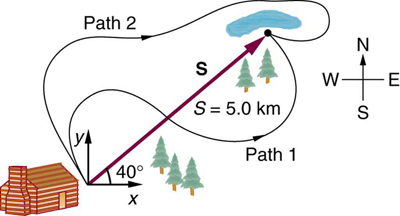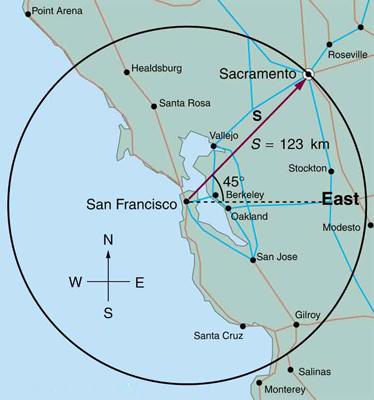Chapter 3 Describing Movement in Two Dimensions, 2-D Linear Kinematics
Conceptual Questions
- Which of the following is a vector: a person’s height, the altitude on Mt. Everest, the age of the Earth, the boiling point of water, the cost of this book, the Earth’s population, the acceleration of gravity?
- Give a specific example of a vector, stating its magnitude, units, and direction.
- What do vectors and scalars have in common? How do they differ?
- Two campers in a national park hike from their cabin to the same spot on a lake, each taking a different path, as illustrated below. The total distance traveled along Path 1 is 7.5 km, and that along Path 2 is 8.2 km. What is the final displacement of each camper?

- If an airplane pilot is told to fly 123 km in a straight line to get from San Francisco to Sacramento, explain why he could end up anywhere on the circle shown in (Figure). What other information would he need to get to Sacramento?

- Suppose you take two steps [latex]\mathbf{\text{A}}[/latex] and [latex]\mathbf{\text{B}}[/latex] (that is, two nonzero displacements). Under what circumstances can you end up at your starting point? More generally, under what circumstances can two nonzero vectors add to give zero? Is the maximum distance you can end up from the starting point [latex]\mathbf{\text{A}}+\mathbf{\text{B}}[/latex] the sum of the lengths of the two steps?
- Explain why it is not possible to add a scalar to a vector.
- If you take two steps of different sizes, can you end up at your starting point? More generally, can two vectors with different magnitudes ever add to zero? Can three or more?
- Suppose you add two vectors [latex]\mathbf{A}[/latex] and [latex]\mathbf{B}[/latex]. What relative direction between them produces the resultant with the greatest magnitude? What is the maximum magnitude? What relative direction between them produces the resultant with the smallest magnitude? What is the minimum magnitude?
- Give an example of a nonzero vector that has a component of zero.
- Explain why a vector cannot have a component greater than its own magnitude.
- If the vectors [latex]\mathbf{A}[/latex] and [latex]\mathbf{B}[/latex] are perpendicular, what is the component of [latex]\mathbf{A}[/latex] along the direction of [latex]\mathbf{B}[/latex]? What is the component of [latex]\mathbf{B}[/latex] along the direction of [latex]\mathbf{A}[/latex]?
3.4 Projectile Motion
- Answer the following questions for projectile motion on level ground assuming negligible air resistance (the initial angle being neither 0º nor 90º):
(a) Is the velocity ever zero?
(b) When is the velocity a minimum? A maximum?
(c) Can the velocity ever be the same as the initial velocity at a time other than at [latex]t=0[/latex]?
(d) Can the speed ever be the same as the initial speed at a time other than at [latex]t=0[/latex]? - Answer the following questions for projectile motion on level ground assuming negligible air resistance (the initial angle being neither 0º nor 90º):
(a) Is the acceleration ever zero?
(b) Is the acceleration ever in the same direction as a component of velocity?
(c) Is the acceleration ever opposite in direction to a component of velocity? - For a fixed initial speed, the range of a projectile is determined by the angle at which it is fired. For all but the maximum, there are two angles that give the same range. Considering factors that might affect the ability of an archer to hit a target, such as wind, explain why the smaller angle (closer to the horizontal) is preferable. When would it be necessary for the archer to use the larger angle? Why does the punter in a football game use the higher trajectory?
- During a lecture demonstration, a professor places two coins on the edge of a table. She then flicks one of the coins horizontally off the table, simultaneously nudging the other over the edge. Describe the subsequent motion of the two coins, in particular discussing whether they hit the floor at the same time.

